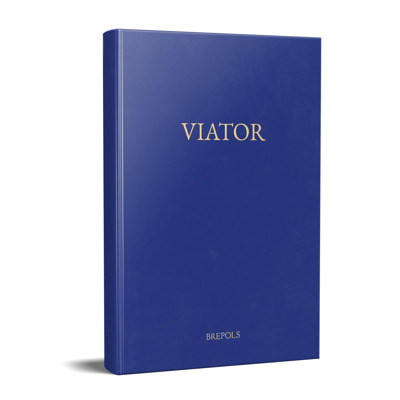
Viator 44, No. 1 (2013)
- Pages: 388 p.
- Size:178 x 254 mm
- Language(s):English
- Publication Year:2013
- € 49,00 EXCL. VAT RETAIL PRICE
- ISBN: 978-2-503-54735-0
- Hardback
- Out of Print
- E-journal
- Available
Natalia Rusnac, “From Villa to Cloister: The Religious Transformation of the Book in Late Antique Gaul”
Leidulf Melve, “‘Even the Very Laymen Are Chattering about It’: The Politicization of Public Opinion, 800–1200”
Sarah Whitten, “Quasi ex uno ore: Legal Performance, Monastic Return, and Community in Medieval Southern Italy”
Natasha R. Hodgson, “Lions, Tigers, and Bears: Encounters with Wild Animals and Bestial Imagery in the Context of Crusading to the Latin East”
Vincent Debiais, “The Poem of Baudri for Countess Adèle: A Starting Point for a Reading of Medieval Latin Ekphrasis”
Ilya Dines, “The Earliest Use of John of Salisbury’s Policraticus: Third Family Bestiaries”
Dawn Marie Hayes, “French Connections: The Significance of the Fleurs-de-Lis in the Mosaic of King Roger II of Sicily in the Church of Santa Maria dell’Ammiraglio, Palermo”
Ayelet Even-Ezra, “The Conceptualization of Charisma in the Early Thirteenth Century”
Irven Resnick, “Luke 22.44 and Sweating Blood: Jesus and Medieval Natural Philosophers”
Jonathan Rubin, “Benoit d’Alignan and Thomas Agni: Two Western Intellectuals and the Study of Oriental Christianity in Thirteenth-century Kingdom of Jerusalem”
L. J. Sackville, “The Inquisitor’s Manual at Work”
Fabrizio Titone, “Aragonese Sicily as a Model of Late Medieval State Building”
Julia Verkholantsev, “St. Jerome As a Slavic Apostle in Luxemburg Bohemia”
Anastasia G. Yangaki, “A First Overview of Late Medieval Pottery from the Iberian Peninsula in Greece”
Cynthia Turner Camp, “Osbern Bokenham and the House of York Revisited”
Megan K. Williams, “Intercepted Love-Letters: Reporting the 1535 Apostolic Nunciature to Hungary”

